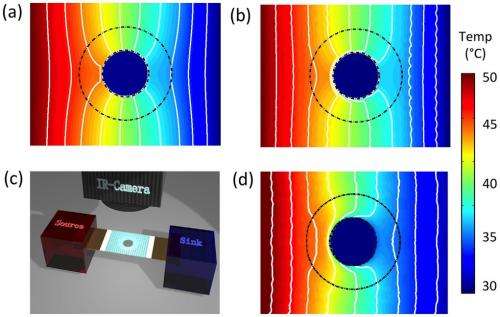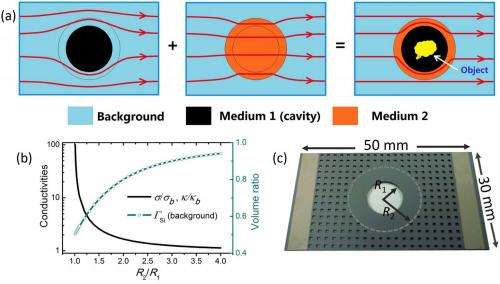November 21, 2014 feature
Multiphysics invisibility cloak manipulates both electric current and heat

Invisibility cloaks can make objects invisible not just to light in the visible part of the spectrum, but to many other physical excitations. These include acoustic waves, matter waves, heat flux, and infrared or ultraviolet electromagnetic (EM) waves. But so far, any single invisibility cloak can manipulate only one of these types of excitations.
Now in a new study, scientists have provided the first experimental demonstration of an invisibility cloak that can simultaneously manipulate two physical excitations: electric current and heat flux. The cloak is made of silicon and other materials, which opens up a range of new applications such as on-chip devices that involve both current and heat, as well as high-performance solar cells.
The researchers, led by Professor Yungui Ma and Professor Sailing He at Zhejiang University in Hangzhou, China, have published a paper on the experimental demonstration of the multiphysics cloak in a recent issue of Physical Review Letters.
"We think the greatest significance of our work is that it first unambiguously proves the practical feasibility to obtain a multi-functional cloaking performance using available materials and fabrication techniques, and that it may inspire much deeper and broader explorations along this exciting direction for different physical systems or in the pursuit of more complicated functionalities," Ma told Phys.org.
The general concept of an invisibility cloak is fairly simple: it is a material that bends light (or other excitation) around an object so that none of the light is scattered by the object, rendering it invisible. In practice, this concept is difficult to achieve because it requires very complicated materials, "metamaterials," which are made of many tiny, precisely engineered elements that respond to the physical excitation in a very specific way.
As the scientists explain in their paper, designing a metamaterial for even a single physical excitation—EM waves or heat flux, for instance—gets complicated very quickly:

"An EM cloak has to take into account both electric and magnetic polarizations, either of which has a maximum number of nine required dynamic elements, while a transient thermal cloak must deal with anisotropic thermal conductivities, thermal capacitance, and density simultaneously. Most of the previous work in this field struggled to satisfy the requirements of one set of physical equations that only controlled and realized one physical phenomenon."
To design a bifunctional electric-thermal invisibility cloak, the scientists first had to show that it is possible to couple different equations into one, and then develop materials to experimentally realize this configuration.
The resulting cloak design consists of a bilayer shell system. The inner layer, called the air cavity, is a strong scatterer that expels electric current or heat flow. The outer layer acts in opposition to the inner layer by attracting and concentrating the current and heat flow. The researchers made this layer out of silicon, a typical semiconductor material. In this case, they used a background made out of silicon with perforated holes filled with polydimethylsiloxane, which has a negligible conductivity compared to silicon. The researchers showed that an optimal combination of these structured materials can cancel out the disturbance caused by an object inside the air cavity, resulting in a cloaking effect.
By integrating two functionalities in a single cloak, the results could have several applications. For example, the cloak could provide the ability to control the electric current and heat of electronic devices. It could also lead to the development of an electric-thermal "Janus" device that can concentrate electric current along one axis while cloaking thermal flux along the orthogonal axis.
"Our current device, purely built on a silicon wafer employing a standard semiconductor fabrication technology, can manipulate both current and heat flows in a desired manner," Ma explained. "Unwanted electric and thermal background disturbances are the two key noise sources that influence the performance (including lifetime) of microelectronic elements integrated in our daily-used electronic devices such as cell phone handsets or laptop computers. The current research may give a potential means to control these disturbances from the original design so that our devices can have a stronger performance on aspects of electric and heat management, which will become more and more important when their sizes keep shrinking and functionalities are getting more powerful.
"The current design is aimed to protect an object both electrically and thermally. The design methodology can be modified to realize multiple functions, i.e., independently controlling electric and heat flows. One direct potential application is that it may help us have a device that can behave as an electric cloak (or shelter) and meanwhile as a thermal concentrator (harvester). In the end it may provide an efficient way to collect and utilize heat (thermal energy) unavoidably generated in all kinds of electronic devices."
Further, Ma explained, the ability to simultaneously control electric current and heat could be useful in thermophotovoltaic technology, the direct conversion of heat to electricity.
"The independent controlling of electric and heat properties may also find very important applications in thermophotovoltaic technology (which has the largest solar-to-electricity transfer efficiency), which desperately requires a material with high electric conductivity but extremely low thermal conductivity," he said. "A similar multiphysics device may be potentially built to meet this stringent requirement using current design methodology."
In the future, the researchers plan to continue working on bifunctional devices and their practical applications.
"Other dual cloaks, such as electrical-magnetic hiding for low frequencies, is one of our current focuses," Ma said. "In addition, we are working on dual functionalities (not for cloaking) by a single device, as mentioned above. Our goal is to find an efficient way to solve the fundamental problems on the undesired electrical-thermal entanglement, e.g., turning the dissipated heat into useful source energy."
More information: Yungui Ma, et al. "Experimentaql Demonstration of a Multiphysics Cloak: Manipulating Heat Flux and Electric Current Simultaneously." Physical Review Letters. DOI: 10.1103/PhysRevLett.113.205501
Journal information: Physical Review Letters
© 2014 Phys.org




















